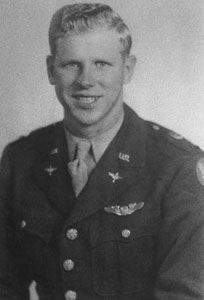|
|
 |
 |
| North American P-51H Mustang | Pilot 2nd Lt Harold Baker |
P-51H Mustang #44-64574, crashed October 5, 1945, near Estrella, Arizona
SUMMARY: 2nd Lt. Harold Baker was a pilot assigned to the Air Transport Command, whose job was to ferry new aircraft from the manufacturing plants to their final destination. On the morning on October 5, 1945, Lt. Baker and another pilot, Lt. Faucett, both flying North American P-51 Mustangs, departed Long Beach AAF in California for Coolidge, Arizona. Soon after the pilots passed high above the Colorado River, they could see dark storm clouds looming directly in their flight path. As the fighters approached Tonopah, Arizona, the storm worsened and the pilots separated in an attempt to each find their own way to Coolidge AAF. Lt. Baker had turned south in an attempt to go around the storm while Lt. Fausett headed north. A short while later, Lt. Faucett looked back and could see Lt. Baker's Mustang flying into a rapidly forming wall of rain and clouds that quickly enveloped the aircraft. Lt. Faucett landed at Coolidge AAF shortly before the storm system hit. Lt. Baker never arrived, and soon after the storm passed, a search was initiated. His wife was notified that he was missing, and three days later on October 8th, she received the news she did not want to hear. The USAAF had found his crashed plane, and tragically, he did not survive. Investigation revealed that the left wing had failed in flight which caused the Mustang to crash. The USAAF determined that Lt. Baker likely experienced vertigo due to the extreme turbulence while in the clouds, and may have placed sufficient stress on the aircraft that resulted in structural failure. |
|
|
|
|
|
| Wing structure that fell from the fighter when the wing collapsed. | Scattered debris at the impact point. | Part of the .50 cal gun assembly. | Molten aluminum shards at the crash site. |
|
|
|
|
|
| Cockpit switches. | The data plate for the Stromberg cauburator. | Small scattered debris at the impact area. | .50 cal ammo feed tray. |
|
|
|
|
|
| This cast aluminum casing may have been from the valve cover. | The adjustment pedal for the seat or rudder pedals. | Various scattered debris. | Sperry avionics mounting plate for the instrument dash. |
|
|
|
|
|
| An access cover. | Parachute harness buckles. | Radio component. | Various buckles. |
|
|
|
|
|
| The armored windscreen. | It is close to 3 inches thick. | Data plate for the manifold pressure. | Canopy plexiglass discolored and crazed after so many years under the harsh sun. |